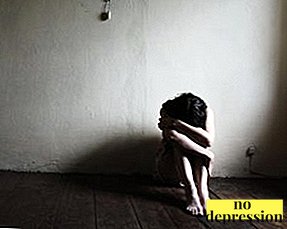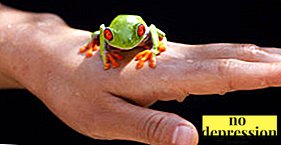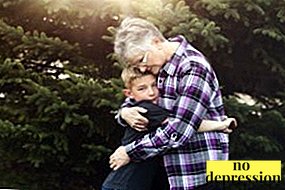Depression, increased anxiety, phobias and others mental disorders It is difficult enough to cure by traditional methods forever.
Drug treatment relieves only the symptoms, not allowing the person to become completely mentally healthy. Psychoanalysis It can bring effect, but it will take years to get a sustainable result (from 5 to 10).
Cognitive-behavioral direction in therapy is young but really working on the healing kind of psychotherapy. It allows people to get rid of despondency and stress in a short time (up to 1 year), replacing destructive patterns of thinking and behavior with constructive ones.
Concept

Cognitive methods in psychotherapy work with a patient's thinking model.
The goal of cognitive therapy is the awareness and correction of destructive patterns (mental schemes).
Treatment result is complete or partial (at the request of the patient) personal and social adaptation of the person.
People, faced with unusual or painful events for themselves at different periods of life, often react negatively, creating tension in the body and brain centers responsible for receiving and processing information. At the same time, hormones are released into the bloodstream, causing suffering and heartache.
In the future, a similar pattern of thinking is fixed by repetition of situations, which leads to mental disorder. Man ceases to live in peace with himself and the outside world, creating yourself your own hell.
Cognitive therapy teaches to respond more calmly and relaxed to the inevitable changes in life, translating them into a positive direction with creative and calm thoughts.
Advantage of the method - work in the present tense, not fixing on:
- past events;
- the influence of parents and other close people;
- feelings of guilt and regret for lost opportunities.
Cognitive therapy allows take destiny in your own hands, freeing themselves from addictions and unwanted influence of others.
For successful treatment, it is desirable to combine this method with behavioral, that is, behavioral.
What is cognitive therapy and how does it work? Find out about this from the video:
Cognitive behavioral approach

Cognitive-behavioral therapy works with the patient in a complex way, combining the creation of constructive mental installations with new behavioral responses and habits.
This means that each new mental installation must be supported by a specific action.
Also, this approach allows revealing destructive patterns of behavior, replacing them with healthy or safe for the body.
Cognitive, behavioral and combination therapy can be applied both under the supervision of a specialist and independently. But still, at the very beginning of the journey, it is advisable to consult with a professional in order to work out the correct treatment strategy.
Spheres of application
The cognitive approach can be applied to all people who feel unhappy, unsuccessful, unattractive, insecure and so forth
An attack of self-torture can happen to anyone. Cognitive therapy in this case can reveal a thinking model that served as a start button for creating a bad mood, replacing it with a healthy one.
Also this approach is used for the treatment of the following mental disorders:
- depression;
- suicidal tendencies;
- panic attacks, anxiety, suspiciousness;
- various kinds of addictions, including alcohol;
 social phobia (fear of communication with people);
social phobia (fear of communication with people);- unreasonable fears;
- eating disorders (anorexia, bulimia);
- attention deficit hyperactivity disorder;
- manic-depressive psychosis;
- antisocial behavior (falsehood, kleptomania, sadism).
Cognitive therapy can remove difficulties in relations with family and friendsand also teach how to establish and maintain new connections, including with the opposite sex.
Opinion of Aaron Beck
American psychotherapist Aaron Temkin Beck (professor of psychiatry at the University of Pennsylvania) is the author of cognitive psychotherapy. He specializes in the treatment of depressive conditions, including suicidal.
For the basis of the approach of A.T. Beck took the term "cognition" (the process of information processing by the mind).
The decisive factor in cognitive therapy is the correct processing of information, as a result of which an adequate program of behavior is fixed in a person.
The patient is in the process of treatment for Beck should change my view of myself, your life situation and tasks. It is necessary to go through three stages:
- recognize their right to make mistakes;
- abandon erroneous ideas and worldviews;
- correct mental patterns (replace inadequate with adequate).

A.T. Beck believes that only correction of erroneous thinking patterns can create a life with a higher level of self-realization.
The creator of cognitive therapy himself effectively applied its techniques to himself when, after successfully curing patients, his income level significantly decreased.
Patients quickly recovered without recurrence, going back to a healthy and happy life, which adversely affected the state of the doctor's account in the bank.
After analyzing the thinking and its correction, the situation has changed for the better. Cognitive therapy suddenly came into vogue, and its creator was offered to write a series of books for a wide range of users.
Aaron Beck: goals and objectives of cognitive psychotherapy. Practical examples in this video:
Cognitive-behavioral psychotherapy
Before treatment, it is recommended to compile a list of problems (targets) in descending order of importance for the patient, as well as to identify automatic destructive thoughts.
After this work, methods, techniques, and exercises of cognitive-behavioral therapy are used, which cause positive changes in a person's life.
Methods

Methods in psychotherapy are called ways to achieve the goal.
In the cognitive-behavioral approach to them include:
- Removing (erasing) destroying thoughts ("I will not succeed," "I am a loser," etc.).
- Creating an adequate world view (“I will do it. If it doesn't work out, then it’s not the end of the world,” etc.).
When creating new thoughtforms, you need to really look at the problems. This means that they may not be decided as planned. Such a fact should also be calmly taken in advance.
- Revision of painful past experience and assessment of the adequacy of his perception.
- Fastening new thought forms with actions (the practice of communicating with people for a sociopath, good nutrition - for anorexic, etc.).
The methods of this type of therapy are used to solve real problems in real time. Excursion into the past is necessary only to create an adequate assessment of the situation in order to create a healthy model of thinking and behavior.
For more information about the methods of cognitive-behavioral therapy can be found in the book "Methods of behavioral therapy" by E. Chesser, V. Meyer.
Techniques
A distinctive feature of cognitive-behavioral therapy is the need active patient participation in his healing.
The patient must understand that his suffering creates the wrong thoughts and behavioral reactions. It is possible to become happy by replacing them with adequate thought forms. To do this, you must perform the following series of techniques.
A diary

Keeping a diary in which it is recommended to write down all negative thoughts, the reason for their appearance.
This technique will allow you to track the most frequently repeated phrases that create problems in life.
- Identify and record destructive thoughts when solving any problem or task.
- Verifying a destructive installation with a specific action.
For example, if a patient claims that “he will fail,” he must do what he can and write it in his diary. The next day is recommended perform a more complicated action.
Why keep a diary? Find out from the video:
Catharsis
In this case, the patient must allow himself to express feelings that he had previously prohibited himself, considering them to be bad or unworthy.
For example, cry, show aggression (in relation to the pillow, mattress), etc.
Visualization
Imagine that the problem has already been solved and remember emotionswhich appeared at the same time.
Techniques of the described approach are detailed in the books:
- Judith Beck “Cognitive Therapy. Complete Guide »
- Ryan Mack Mullin "Practice of Cognitive Therapy"
Methods of cognitive-behavioral psychotherapy:
Exercises for self-fulfillment
To correct your thinking, behavior and solving problems that seem intractable, it is not necessary to immediately turn to a professional. First you can try the following exercises:
 Sheet of paper divided into two columns. At the top of the left draw a “-” sign, and at the top of the right - “+”. Then, in the minus column, write all your character traits and problems that you need to get rid of, and the right one - constructive thoughts and wishes. For example, on the left - laziness, on the right - enthusiasm or inspiration.
Sheet of paper divided into two columns. At the top of the left draw a “-” sign, and at the top of the right - “+”. Then, in the minus column, write all your character traits and problems that you need to get rid of, and the right one - constructive thoughts and wishes. For example, on the left - laziness, on the right - enthusiasm or inspiration.After creating the list, the left side is cut off and burned (torn into small pieces), and the right one is saved. The exercise is repeated once every ten days. Positive changes begin after 20 days.
- "Smile". Every morning and every evening for 30-40 minutes. “Wear” a smile on your face, regardless of how you feel and the type of activity. You do not need to force yourself to happiness, radiation of love, etc. The main task is to slightly raise the corners of the mouth with a smile (if you wish, you can be stronger). Exercise done at least 40 days in a row.
- "Whip". In this case, it is recommended that when you track destructive thoughts, it hurts yourself. To this end, you can wear a special rubber bracelet, pulling it off and releasing it on your arm, creating a painful effect. You can also press with a fingernail on the fingertip. This exercise is not recommended for survivors of violence and trauma. It is desirable to combine it with the exercise "Smile".
- "Gingerbread". When performing this exercise, you need to encourage yourself for every constructive thought. "Premium" you can give yourself a taste (fruit, candy), tactile (massage, aromatic bath), cash or other equivalents. The main task at the same time - getting pleasure to secure an adequate program.
 "Frog". The name of the exercise came from the English proverb - “start the morning with a frog”. This means that each working day must begin with the performance of one unpleasant affair, which has long been postponed. The main thing here is not to overdo it (it should be one thing), but not to miss it, arguing that tomorrow there will be two "frogs". Exercise requires a great deal of self-discipline and self-control, since during execution it is necessary to keep track of destructive thought forms, replacing them with adequate ones.
"Frog". The name of the exercise came from the English proverb - “start the morning with a frog”. This means that each working day must begin with the performance of one unpleasant affair, which has long been postponed. The main thing here is not to overdo it (it should be one thing), but not to miss it, arguing that tomorrow there will be two "frogs". Exercise requires a great deal of self-discipline and self-control, since during execution it is necessary to keep track of destructive thought forms, replacing them with adequate ones.- "Stop". This exercise can be performed throughout the day by saying “stop” to yourself while tracking negative thoughts. For all its simplicity, the exercise is very effective. It abruptly stops the negative word mixer. Effort is required when starting a constructive stream of thoughts.
It has an amazing effect on mood, gradually raising it day after day.
The exercises are discussed in great detail in the book. S. Kharitonov "Guidelines for cognitive-behavioral therapy."
Also in the treatment of depression and other mental disorders, it is advisable to master several relaxation exercises using auto-training techniques and breathing exercises.
additional literature
Cognitive-behavioral therapy - young and very interesting approach not only for the treatment of mental disorders, but also to create a happy life at any age, regardless of the level of welfare and social success. For more in-depth study or training, the following books are recommended:
 John Robert Anderson "Cognitive Psychology"
John Robert Anderson "Cognitive Psychology"- Readings "Horizons of cognitive psychology"
- D. Kaneman, P. Slavik, A. Tversky “Decision Making in Uncertainty. Rules and Prejudices
Cognitive-behavioral therapy based on world view correctionwhich is a series of beliefs (thoughts). For successful treatment, it is important to recognize the irregularity of the established model of thinking and replace it with a more adequate one.

 social phobia (fear of communication with people);
social phobia (fear of communication with people); Sheet of paper divided into two columns. At the top of the left draw a “-” sign, and at the top of the right - “+”. Then, in the minus column, write all your character traits and problems that you need to get rid of, and the right one - constructive thoughts and wishes. For example, on the left - laziness, on the right - enthusiasm or inspiration.
Sheet of paper divided into two columns. At the top of the left draw a “-” sign, and at the top of the right - “+”. Then, in the minus column, write all your character traits and problems that you need to get rid of, and the right one - constructive thoughts and wishes. For example, on the left - laziness, on the right - enthusiasm or inspiration. "Frog". The name of the exercise came from the English proverb - “start the morning with a frog”. This means that each working day must begin with the performance of one unpleasant affair, which has long been postponed. The main thing here is not to overdo it (it should be one thing), but not to miss it, arguing that tomorrow there will be two "frogs". Exercise requires a great deal of self-discipline and self-control, since during execution it is necessary to keep track of destructive thought forms, replacing them with adequate ones.
"Frog". The name of the exercise came from the English proverb - “start the morning with a frog”. This means that each working day must begin with the performance of one unpleasant affair, which has long been postponed. The main thing here is not to overdo it (it should be one thing), but not to miss it, arguing that tomorrow there will be two "frogs". Exercise requires a great deal of self-discipline and self-control, since during execution it is necessary to keep track of destructive thought forms, replacing them with adequate ones. John Robert Anderson "Cognitive Psychology"
John Robert Anderson "Cognitive Psychology"

